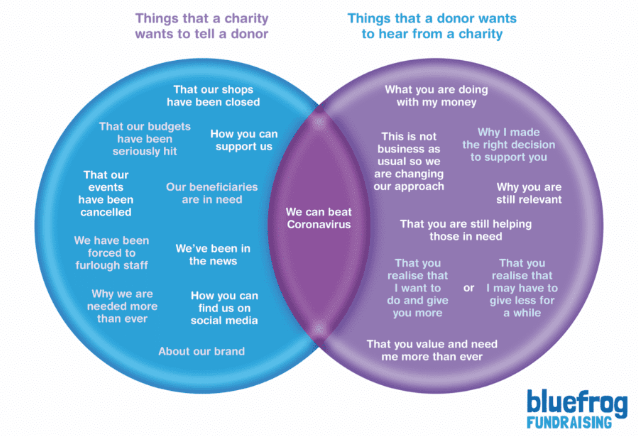 Could you be getting it all wrong when it comes to the what, who, where, why, how and when of your nonprofit’s communications and fundraising as this pandemic plays out?
Could you be getting it all wrong when it comes to the what, who, where, why, how and when of your nonprofit’s communications and fundraising as this pandemic plays out?
You could.
Especially if you’re leading from opinion above knowledge. You know, going with your gut when it comes to what your donors want or need from you right now. Otherwise known as guessing.
That’s never a good idea for someone whose job is to facilitate philanthropy. Because a lot is known about how much joy it brings people to demonstrate their ‘love of humanity’ through philanthropic acts. Your gut telling you donors don’t want to be invited to become heroes? P’shaw.
Now, thanks to the folks at Blue Frog Fundraising, more is known about how donors feel about giving in response to the current pandemic. In the recently revealed Coronavirus Research Findings: What do donors think now? they focus on what donors have told them about how their approach to giving has changed. Or hasn’t.
These philanthropy trends are important to understand, so I’ve selected the most salient among their key findings (highlighted in the break-out boxes) and have grouped them according to the traditional journalist’s rubric of what, who, where, why, how and when.
 I’m going to explain what your nonprofit should do to show donors you do, in fact, understand where they’re coming from.
I’m going to explain what your nonprofit should do to show donors you do, in fact, understand where they’re coming from.
Before taking any marketing message or fundraising appeal off your plate, and before adding anything new, always make sure to ask yourself these six important questions! They will help you assess almost any situation, plus focus your efforts and aid you in telling more relevant, compelling stories.
Let’s get started…
1. WHAT?
 What is really going on right now, and is our plan in tune?
What is really going on right now, and is our plan in tune?
“Giving is increasingly seen as good – as is fundraising. Even donors who have been hit economically are remaining remarkably generous.”
Right now is still the ‘bump,’ not the ‘slump’ stage. Folks who love you haven’t stopped loving you. They want you to survive and thrive. People are still giving. Your donors, especially, are still giving.
Current research backs this up.
- A study by Fidelity Charitable found 79% of $1,000+ donors plan to maintain or increase their giving, mostly to their current favorite charities.
- Lower to mid-level annual donors have remained the most steadfast through all economic uncertainties.
- AFP data suggests donors will support nonprofits during uncertain times.
Psychology research also reveals committed consistent supporters want to stay that way! It’s actually one of Robert Cialdini’s Principles of Influence that affect human behaviors. Folks are social creatures bent on creating and sustaining social bonds. If they’ve said “yes” to you once they’re more likely to do so again to demonstrate their consistency and commitment. This principle is also known as “foot in the door.”
With supporters with whom you have a foot in the door, now is the time to hold your door wide open. Don’t slam it shut by going silent on folks. At least if you want your donors to stick with you. As tempting as it may be to let your donor communications slide because you’re short-staffed, or just not sure what to say, do not succumb to this temptation.
 What to do first
What to do first
Take the time to appreciate your donors BEFORE you send another solicitation. Send donors thoughtful, sensitive, authentic communications that treat them like members of your family. Show them you love them and care about them and really want to stay in touch. Make donor thank you calls. Send thank you emails. Thank donors repeatedly, and they’ll be more likely to keep your organization on their short list of favored causes.
“Really acknowledge the value of these donors because those people will stick with you. If they have to give a little less, they’ll give something because it’s important to them, and then when this is all over, you’ll have all these donors to move forward with.”
— Melissa Wyers, Executive Director, EveryAction
2. WHO?
 Who are the charities raising money right now, and who are the donor prospects we should be prioritizing?
Who are the charities raising money right now, and who are the donor prospects we should be prioritizing?
“Charities that have little relevance to tackling Coronavirus will still receive support from donors that value them.”
Don’t fall prey to the notion that you’ve no longer got relevance if you aren’t a front-line responder in the battle to fight this pandemic. Or even to directly help those affected by this pandemic. Everyone is affected. And in more ways than one. Think about how your loyal supporters might be affected were your nonprofit to cease to thrive. These folks value your mission, and you need to connect with them and let them know why your mission still matters.
 Who to prioritize before you ask
Who to prioritize before you ask
Segment your database and begin by pulling lists of those most likely to give to you right now.
- Begin with recency as a criteria.Those who’ve given to you in the past year are your most loyal, committed supporters. Lapsed donors may give. But they’re not your priority right now as your percentage return on investment will be low.
- Talk with major donor prospects first. These supporters are your bread and butter. I know it seems obvious, and it is, but sometimes folks find it harder to pick up the phone and ask for additional gifts from those who’ve already been generous than simply send a blast email to lower-level donors. Don’t make that mistake.
- Talk with major donor prospects you’ve been intending to ‘qualify’to be included in your cultivation (moves management) portfolio. These are your targets for additional gifts and upgrades. Whereas in ordinary times you may have kept these folks on the back burner for too long (failing to strike while the iron is hot), now is your golden opportunity. Whereas in the past they might not have had the bandwidth or inclination to open the door you’ve got your foot in, today is extraordinary. They just may want to build a relationship with someone right now; it might as well be you!
- Reach out to purchasers of services who may be willing to forego a refund and convert to a donation. I’ve talked with organizations having great success with this strategy for cancelled performances, fundraising events, camps and even memberships. If they’re not willing to forego the full refund, perhaps you can agree to a split – and maybe offer some sort of ‘gift’ as a token of your appreciation. It could be first dibs on camp spaces next year. Or upgraded seats once your arts organization is back up and running. Or it can even be as simple as a downloadable certificate you send them that says “I Helped Save [Name of Your Organization] during the 2020 Coronavirus Pandemic!”
3. WHERE?
 Where are donors seeing messaging from nonprofits?
Where are donors seeing messaging from nonprofits?
“Donors still see very few requests from charities.”
Be the one who shows up! Donors who loved your mission yesterday will still love it today. But they’re unlikely to give if you don’t ask. Don’t go dark on them!
Supporters want to find you in their inbox. They want to know what’s going on, and also want to know how they can help. This brings them meaning, purpose and joy. Don’t deny them this opportunity! Most nonprofits don’t email enough in general.
 Where to send your message today, not tomorrow.
Where to send your message today, not tomorrow.
Craft a plan to send regular messages, including asks. Resist the temptation to wait until this blows over. By then, you may have blown over too. And you don’t want to be like Humpty Dumpty. Don’t fall apart, so you don’t have to be put back together. Which didn’t work out for our friend Dumpty. And, guess what? Your supporters don’t want you to fall apart!
You still have time to ask while folks are feeling a genuine need to be helpful. Many nonprofits are having success with even more than one email per week (e.g. one update and one appeal). Make sure appeals are segmented by constituency so asks can be as specific as possible (both amount and purpose). Rather than asking for gifts for ‘normal’ purposes, consider addition of a targeted “Coronavirus Response or Resiliency Fund.”
4. WHY?
 Why are people giving now?
Why are people giving now?
“This has threatened loyalty to charities that are seen as irrelevant or not in need of funds (as they haven’t asked for help).”
“The news cycle remains a driver and predictor of relevance.”
As noted above, make sure you’re asking regularly. Try to tap into whatever is happening in the news that makes what you do especially important in today’s environment. It may be direct frontline service. It may be aspirational, inspiring or therapeutic. It may be finding a cure for another debilitating disease that’s still just as much a threat today as it ever was (and it may even predispose people to succumb to the coronavirus by compromising their immune systems).
In Oprah Winfrey’s recent address to the graduating class of 2020 she noted the meaning of the word “graduate” is “to step forward.” “Every one of us is now being called to graduate, to step toward something, even though we don’t know what.” It’s okay to ask your supporters to step forward with you into the unknown right now, as long as you describe your particular unknown and how your ability to move forward with strength relates to what’s going on in the world.
 What to do to speak to the current ‘why’ of your mission
What to do to speak to the current ‘why’ of your mission
Reshape your case for support to focus on what donors want/need to hear about how you’re adapting your work to the new reality. Perhaps you actually need to ramp up services. Or you’re delivering services from a physical distance. Or you’ve pivoted to online programming. Or you’re dedicating to protecting workers, sustaining staff salaries and providing vital benefits. Be as specific as possible. No “these are difficult times” without following with “this is how we’re adapting to this present situation.”
Share any good news you have to offer. It may be you got a PPP loan to tide you over. Or it may be you have a new plan to pivot programs to a different format. Good news will offer donors hope, and make them feel better about your prospects for survival. This will make them more likely to stay on board.
5. HOW?
 How are the best messages being crafted?
How are the best messages being crafted?
“With people and companies under financial threat, charities are not seen to be a special case. Only some causes can comfortably focus on the threat of closure as an appeal subject. Other charities should avoid it.”
The entire world is in freefall today; it’s not just charities. Your donors are receiving requests for donations from small businesses and neighborhood restaurants. They may be receiving ‘go fund me’ appeals from individual people they know who need support. So you don’t have just being a ‘do-gooder nonprofit’ to fall back on. You must really make a strong, cogent case for support. You should always do this, of course. The difference now is you can’t get away with simply being ‘a good cause.’ Your best message is a passionate one.
 How to craft a credible case for philanthropy today
How to craft a credible case for philanthropy today
Be clear what the donor’s gift will be used for. This is imperative. Don’t just say “times are tough and we’re going to need more money.” Set a goal so donors can step up to the plate to help you meet that goal. People don’t want their money going into a black hole. Let folks know why you need them to step up to the plate right now. Use the magic word “because … you’re experiencing a shortfall… needing to ramp up emergency response efforts…” and so forth.
Get testimonials from frontline workers, beneficiaries and supporters about how essential your work is. You can do this, after a fashion, even if you’re not a medical, healthcare, science, child care, animal rescue or food delivery organization. For example, arts organizations can solicit feedback from folks who appreciated a virtual theater broadcast, streaming music or shared video uploaded to YouTube. Environmental organizations can share beautiful nature photos; then ask folks to comment on how these made them feel.
 What should you use? The term Coronavirus or Covid-19?
What should you use? The term Coronavirus or Covid-19?
It turns out, the less accurate term is the winner – at least at this point in time. This is something I’d actually been wondering about, so was delighted to find some research into this issue.
Feedback from our research into donor attitudes to giving during the current time has shown that apart from one individual, everyone that we have spoken to uses the term Coronavirus not COVID-19. I’d suggest you use this in your communications as it is the term people recognise and use. A quick search on Google Trends over the last three months shows how dominant the use of Coronavirus is. Covid-19 is growing in popularity – particularly in the broadsheet press – but is nowhere near as common a term as Coronavirus… If you have already launched a strongly branded Covid-19 campaign, I don’t think that you need to rename it. Just make sure that you use the term Coronavirus as well.
— Mark Phillips, Bluefrog, on Queer Ideas blog.
6. WHEN?
 When is the best time to ask?
When is the best time to ask?
“We expect the upswing in philanthropy to continue.”
There’s no time like the present. Literally. The future is so uncertain, it makes no sense to wait for it. It could be better for your donors; it could also be worse. Right now, the data is showing us it’s still a good time to ask.
Don’t worry about intruding on a time when folks have their own worries. You should never presume to make someone else’s decision. People can say ‘no’ for themselves. And, in fact, I’ve found the times people are facing their darkest hours are precisely the times they most want to connect with and help others.
 When to send your next appeal
When to send your next appeal
How about this week? Or next week at the latest? Why not? The art of fundraising is connecting with what’s in your own heart, acting on it and sharing your values and passion with others. If you keep your powder dry, nothing will happen. As hockey great Wayne Gretzky was known to say: “You miss 100% of the shots you don’t take.” You can’t succeed unless you try. So figure out what’s essential about your mission. Dig deep.
Let’s close with a little more graduation speech:
“What will your essential service be? What really matters to you? The fact that you’re alive means you’ve been given a reprieve to think deeply about that question. How will you use what matters in service to yourself, your community and the world?”
— Oprah Winfrey
Want More to Craft Your Compelling Appeal Today?
 Grab my Anatomy of a Fundraising Appeal + Sample Template. It’s good for today. It’s good for tomorrow. It includes all the elements that make an appeal — any appeal — successful.
Grab my Anatomy of a Fundraising Appeal + Sample Template. It’s good for today. It’s good for tomorrow. It includes all the elements that make an appeal — any appeal — successful.
If you follow these guidelines, you’ll raise more money.
Not satisfied? All Clairification products come with a 30-day, no-questions-asked, 100% refund guarantee. The only way you lose? You got it — it’s by not trying. This is a great time to learn something new!
All images photographed by me during one of my pandemic strolls around San Francisco’s neighborhoods.So much beautiful wall art!
-
Pingback: Coronavirus & Nonprofits: Resources for Responding to COVID-19 - Wired Impact




